扩展卡尔曼滤波(EKF)应用于GPS-INS组合导航
- 格式:docx
- 大小:13.55 KB
- 文档页数:3
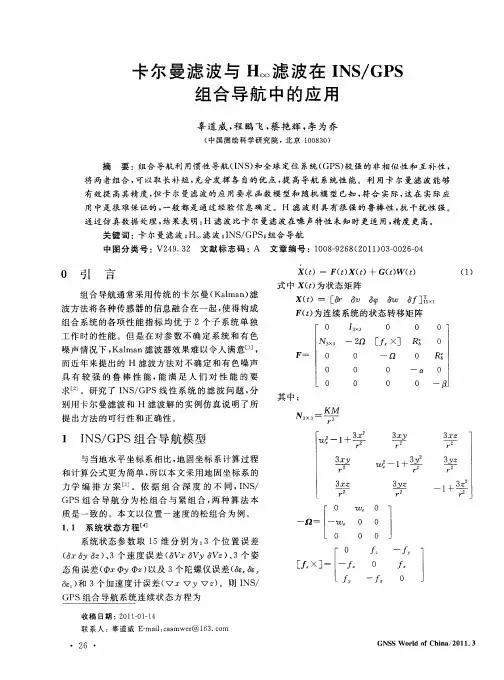
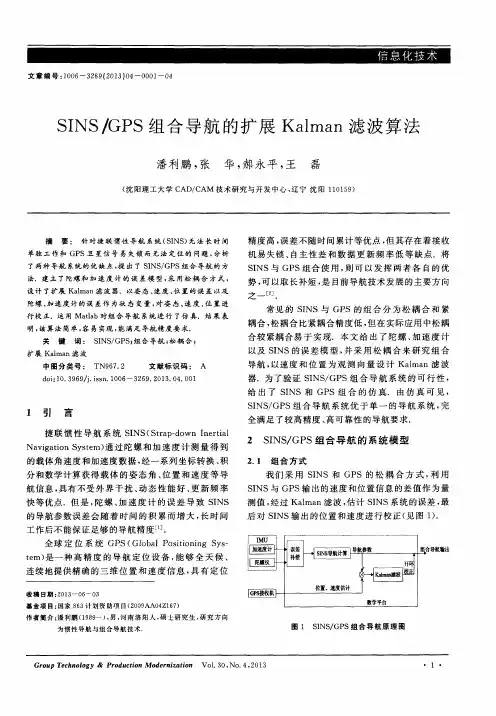
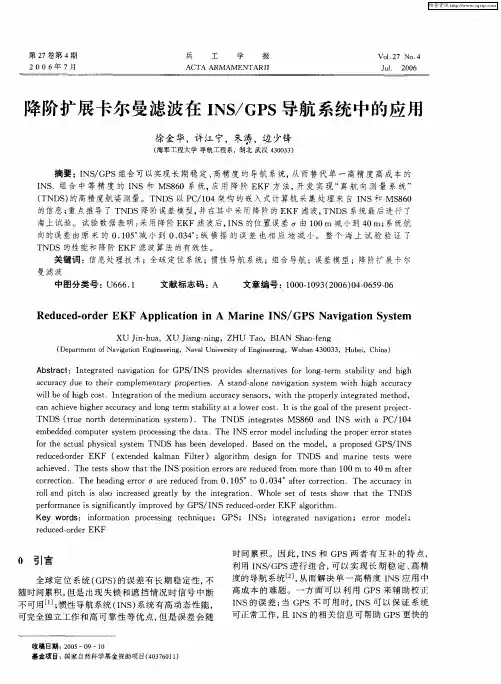

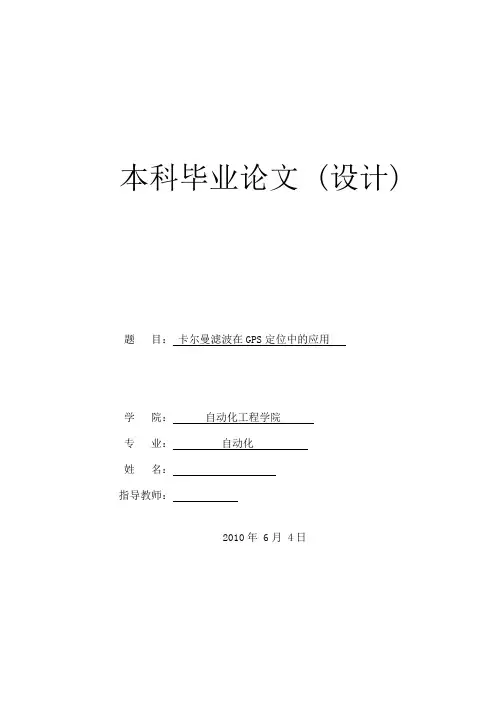
本科毕业论文 (设计)题目:卡尔曼滤波在GPS定位中的应用学院:自动化工程学院专业:自动化姓名:指导教师:2010年 6月 4日The Application of Kalman Filtering for GPS Positioning摘要本文提出了一种应用卡尔曼滤波的GPS滤波模型。
目前在提高GPS定位精度的自主式方法研究领域,普遍采用卡尔曼滤波算法对GPS定位数据进行处理。
由于定位误差的存在,在GPS动态导航定位中,为提高定位精度,必须对动态定位数据进行滤波处理。
文中在比较分析各种动态模型的基础上,提出了应用卡尔曼滤波的GPS滤波模型,并通过对实测滤波算例仿真,证实了模型的可行性和有效性。
最后提出了卡尔曼滤波在GPS定位滤波应用中的问题和改进思路。
关键词 GPS 卡尔曼滤波定位误差AbstractThis article proposed applies the GPS filter model of the Kalman filtering. At present, to improve GPS positioning accuracy in the autonomous areas of research methods, we commonly use Kalman filter algorithm to process GPS location data.As a result of the position error existence in the GPS dynamic navigation localization, we must carry on filter processing to the dynamic localization data for the enhancement pointing accuracy.In the base of comparing each kind of dynamic model, this article proposed applies the GPS filter model of the Kalman filtering,the actual examples of filter calculation are simulated, it confirmed that the model is feasibility and validity. Finally, this article also proposed the existing problems and improving the idea ofthe applications of Kalman filter in GPS positioning.Keywords GPS Kalman filtering Positioning error目录前言 (1)第1章绪论 (3)1.1GPS的简介及应用 (3)1.2本课题的背景及意义 (5)1.3国内外研究动态及发展趋势 (7)1.4目前GPS定位系统面临着新的困扰和挑战 (5)第2章 GPS全球定位系统及GPS定位误差分析 (8)2.1GPS全球定位系统组成部分 (8)2.1.1 GPS卫星星座 (8)2.1.2 地面支持系统 (9)2.1.3 用户部分 (10)2.2GPS定位原理和测速原理 (16)2.2.1 卫星无源测距定位和伪距测量定位原理 (17)2.2.2 多普勒测量定位原理 (193)2.2.3 GPS测速原理 (214)2.3GPS定位误差分析 (225)2.3.1 星钟误差 (225)2.3.2 星历误差 (225)2.3.3 电离层和对流层的延迟误差 (236)2.3.4 多路径效应引起的误差 (246)2.3.5 接收设备误差 (246)2.3.6 GPS测速误差 (257)第3章卡尔曼滤波理论 (27)3.1卡尔曼滤波理论的工程背景 (27)3.2卡尔曼滤波理论 (28)第4章卡尔曼滤波在GPS定位中的应用 (34)4.1卡尔曼滤波在GPS定位中的应用概述 (34)4.2运动载体的动态模型 (35)4.3卡尔曼滤波模型 (36)4.3.1 状态方程 (36)4.3.2系统的量测方程 (37)4.4滤波仿真和结论 (37)第5章卡尔曼滤波在GPS定位应用中的问题和改进思路 (40)5.1对野值的处理 (40)5.2对状态以及观测噪声方差阵的处理 (41)5.3对观测噪声和测量噪声的处理 (42)结论 (30)谢辞 (31)参考文献 (47)前言自从赫兹证明了麦克斯韦的电磁波辐射理论以后,人们便开始了对无线电导航定位系统研究。
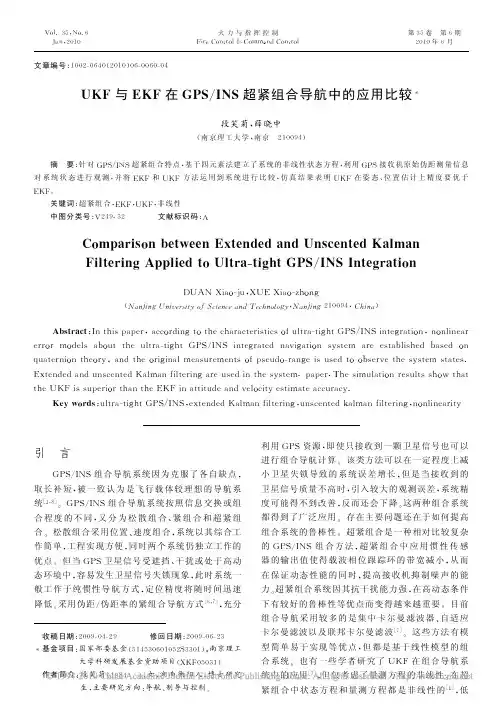
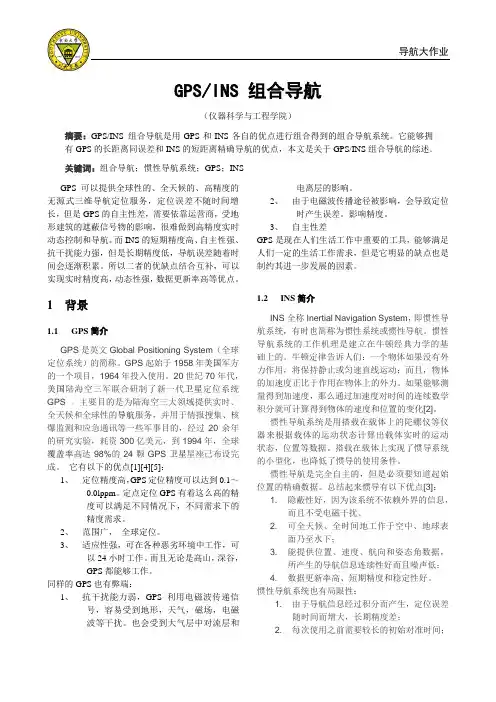
GPS/INS 组合导航(仪器科学与工程学院)摘要:GPS/INS 组合导航是用GPS和INS各自的优点进行组合得到的组合导航系统。
它能够拥有GPS的长距离同误差和INS的短距离精确导航的优点,本文是关于GPS/INS组合导航的综述。
关键词:组合导航;惯性导航系统;GPS;INSGPS可以提供全球性的、全天候的、高精度的无源式三维导航定位服务,定位误差不随时间增长,但是GPS的自主性差,需要依靠运营商,受地形建筑的遮蔽信号物的影响,很难做到高精度实时动态控制和导航。
而INS的短期精度高、自主性强、抗干扰能力强,但是长期精度低,导航误差随着时间会逐渐积累。
所以二者的优缺点结合互补,可以实现实时精度高,动态性强,数据更新率高等优点。
1背景1.1 GPS简介GPS是英文Global Positioning System(全球定位系统)的简称。
GPS起始于1958年美国军方的一个项目,1964年投入使用。
20世纪70年代,美国陆海空三军联合研制了新一代卫星定位系统GPS 。
主要目的是为陆海空三大领域提供实时、全天候和全球性的导航服务,并用于情报搜集、核爆监测和应急通讯等一些军事目的,经过20余年的研究实验,耗资300亿美元,到1994年,全球覆盖率高达98%的24颗GPS卫星星座己布设完成。
它有以下的优点[1][4][5]:1、定位精度高,GPS定位精度可以达到0.1~0.0lppm。
定点定位GPS有着这么高的精度可以满足不同情况下,不同需求下的精度需求。
2、范围广,全球定位。
3、适应性强,可在各种恶劣环境中工作,可以24小时工作。
而且无论是高山,深谷,GPS都能够工作。
同样的GPS也有弊端:1、抗干扰能力弱,GPS利用电磁波传递信号,容易受到地形,天气,磁场,电磁波等干扰。
也会受到大气层中对流层和电离层的影响。
2、由于电磁波传播途径被影响,会导致定位时产生误差。
影响精度。
3、自主性差GPS是现在人们生活工作中重要的工具,能够满足人们一定的生活工作需求,但是它明显的缺点也是制约其进一步发展的因素。

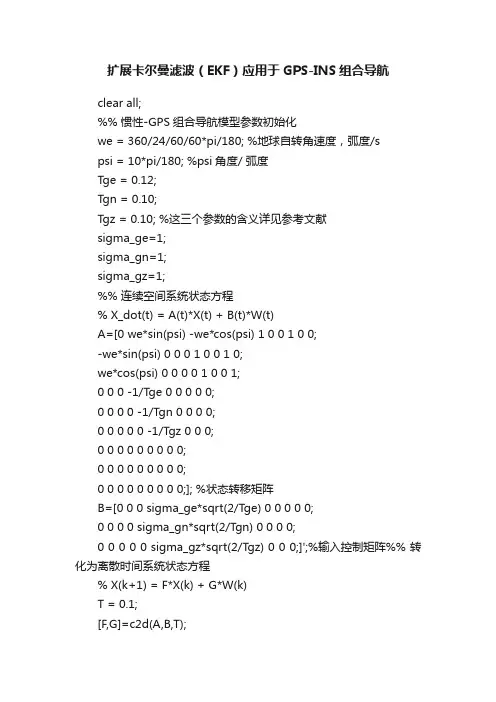
扩展卡尔曼滤波(EKF)应用于GPS-INS组合导航clear all;%% 惯性-GPS组合导航模型参数初始化we = 360/24/60/60*pi/180; %地球自转角速度,弧度/spsi = 10*pi/180; %psi角度/ 弧度Tge = 0.12;Tgn = 0.10;Tgz = 0.10; %这三个参数的含义详见参考文献sigma_ge=1;sigma_gn=1;sigma_gz=1;%% 连续空间系统状态方程% X_dot(t) = A(t)*X(t) + B(t)*W(t)A=[0 we*sin(psi) -we*cos(psi) 1 0 0 1 0 0;-we*sin(psi) 0 0 0 1 0 0 1 0;we*cos(psi) 0 0 0 0 1 0 0 1;0 0 0 -1/Tge 0 0 0 0 0;0 0 0 0 -1/Tgn 0 0 0 0;0 0 0 0 0 -1/Tgz 0 0 0;0 0 0 0 0 0 0 0 0;0 0 0 0 0 0 0 0 0;0 0 0 0 0 0 0 0 0;]; %状态转移矩阵B=[0 0 0 sigma_ge*sqrt(2/Tge) 0 0 0 0 0;0 0 0 0 sigma_gn*sqrt(2/Tgn) 0 0 0 0;0 0 0 0 0 sigma_gz*sqrt(2/Tgz) 0 0 0;]';%输入控制矩阵%% 转化为离散时间系统状态方程% X(k+1) = F*X(k) + G*W(k)T = 0.1;[F,G]=c2d(A,B,T);H=[1 0 0 0 0 0 0 0 0;0 -sec(psi) 0 0 0 0 0 0 0;];%观测矩阵%% 卡尔曼滤波器参数初始化t=0:T:50-T;length=size(t,2);y=zeros(2,length);Q=0.5^2*eye(3); %系统噪声协方差R=0.25^2*eye(2); %测量噪声协方差y(1,:)=2*sin(pi*t*0.5);y(2,:)=2*cos(pi*t*0.5);Z=y+sqrt(R)*randn(2,length); %生成的含有噪声的假定观测值,2维X=zeros(9,length); %状态估计值,9维X(:,1)=[0,0,0,0,0,0,0,0,0]'; %状态估计初始值设定P=eye(9); %状态估计协方差%% 卡尔曼滤波算法迭代过程for n=2:lengthX(:,n)=F*X(:,n-1);P=F*P*F'+ G*Q*G';Kg=P*H'/(H*P*H'+R);X(:,n)=X(:,n)+Kg*(Z(:,n)-H*X(:,n));P=(eye(9,9)-Kg*H)*P;end%% 绘图代码figure(1)plot(y(1,:))hold on;plot(y(2,:))hold off;title('理想的观测量');figure(2)plot(Z(1,:))hold on;plot(Z(2,:))hold off;title('带有噪声的观测量'); figure(3) plot(X(1,:))hold on;plot(X(2,:))hold off;title('滤波后的观测量');。
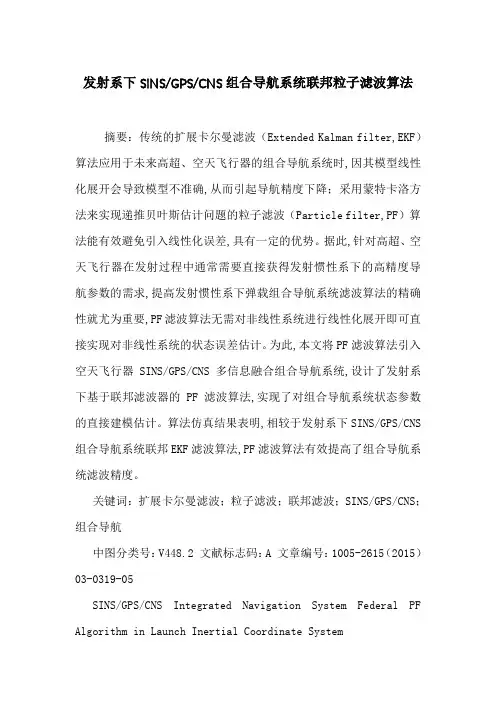
发射系下SINS/GPS/CNS组合导航系统联邦粒子滤波算法摘要:传统的扩展卡尔曼滤波(Extended Kalman filter,EKF)算法应用于未来高超、空天飞行器的组合导航系统时,因其模型线性化展开会导致模型不准确,从而引起导航精度下降;采用蒙特卡洛方法来实现递推贝叶斯估计问题的粒子滤波(Particle filter,PF)算法能有效避免引入线性化误差,具有一定的优势。
据此,针对高超、空天飞行器在发射过程中通常需要直接获得发射惯性系下的高精度导航参数的需求,提高发射惯性系下弹载组合导航系统滤波算法的精确性就尤为重要,PF滤波算法无需对非线性系统进行线性化展开即可直接实现对非线性系统的状态误差估计。
为此,本文将PF滤波算法引入空天飞行器SINS/GPS/CNS多信息融合组合导航系统,设计了发射系下基于联邦滤波器的PF滤波算法,实现了对组合导航系统状态参数的直接建模估计。
算法仿真结果表明,相较于发射系下SINS/GPS/CNS 组合导航系统联邦EKF滤波算法,PF滤波算法有效提高了组合导航系统滤波精度。
关键词:扩展卡尔曼滤波;粒子滤波;联邦滤波;SINS/GPS/CNS;组合导航中图分类号:V448.2 文献标志码:A 文章编号:1005-2615(2015)03-0319-05SINS/GPS/CNS Integrated Navigation System Federal PF Algorithm in Launch Inertial Coordinate SystemXiong Zhi,Pan Jialiang,Lin Aijun,Du Huajun,Yu FengAbstract:When the traditional extended Kalman filter (EKF)algorithm is used in integrated navigation system of future aircraft, it may lead to the inaccuracy of the model because of linearization and the decreasing of navigation precision. Particle filter (PF) solves Bayes estimation problem by using Monte Carlo method and can effectively avoid bringing in linearization error. Consequently, aimed at the requirement of high accuracy for the navigation system state parameters in launch inertial coordinate system, it is particularly important to improve the accuracy of filter algorithm for missile-borne integrated navigation system. The PF algorithm can directly achieve an error estimation without linearization of nonlinear system. This paper brings PF algorithm into the SINS/GPS/CNS integrated navigation system. PF algorithm is designed based on federal filter and the navigation system state parameters are estimated directly. The algorithm simulation results indicate PF algorithm effectively improves filtering precision compared with EKF algorithm and is very suitable for integrated navigation system.基金项目:国家自然科学基金(xxxx,xxxx,xxxx,xxxx,xxxx)资助项目;江苏省六人人才高峰(2013-JY-013)资助项目;江苏高校优势学科建设工程资助项目;中央高校基本科研业务费专项资金资助项目;南京航空航天大学大学研究生创新基地(实验室)开放基金(kfjjxxxx)资助项目。
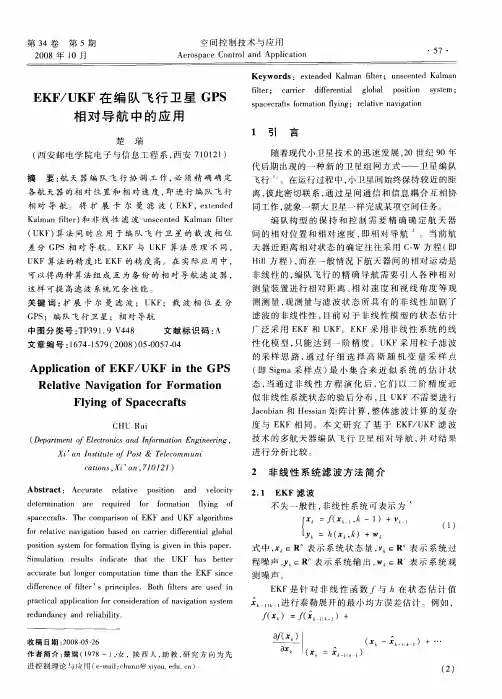
INS-DVL组合导航关键技术研究INS/DVL组合导航关键技术研究摘要:随着全球定位系统(GPS)在海洋环境中的局限性变得越来越明显,需要开发新的导航方法。
航行员在深海中的航行越来越需要高精度的导航支持,因此人们开始研究将惯性导航系统(INS)和多普勒速度测量装置(DVL)相结合的技术,以获得更为准确的位置和速度信息。
INS/DVL组合导航系统受到了广泛的关注,但其在复杂海洋环境下实现高精度导航仍面临一些问题。
本文对INS/DVL组合导航系统的技术原理、误差来源、错误补偿方法、导航滤波算法及其在复杂海洋环境中的应用进行了综述,旨在为航海领域研究者提供一些参考。
关键词:惯性导航系统、多普勒速度测量装置、组合导航、导航滤波算法、海洋环境。
正文:一、概述INS/DVL组合导航系统是利用惯性测量单位和多普勒速度测量仪的数据信息融合实现高精度导航的一种方法。
INS能够提供船舶的加速度和艏向角速度信息,而DVL则可测量船舶在流场中的速度。
许多研究表明INS/DVL组合导航系统具有高精度、持续性、自主性等优点,因而受到广泛的研究和应用。
但在应用过程中,INS/DVL组合导航系统仍会受到各种误差的干扰,包括INS的器件误差、DVL的测量误差、环境的干扰等。
这些误差会影响导航系统的性能,甚至导致导航失败。
因而,需要采取措施进行错误补偿和优化算法选择。
二、 INS/DVL组合导航系统技术原理一般而言,INS/DVL组合导航系统的技术原理可分为以下步骤:INS惯性测量单位和DVL装置同步输出数据,然后将二者数据融合并通过滤波处理,最终得到位置和速度信息。
(1)惯性测量单位惯性测量单位由加速计和陀螺仪两种传感器组成。
加速计可测量船舶的加速度,而陀螺仪可以测量艏向角速度。
INS系统将两种传感器的数据转换为三维坐标系下的位置和速度信息。
(2)多普勒速度测量装置多普勒速度测量装置能够测量船舶在流场中的速度。
将其输出的速度矢量信息转换成体坐标系下的船体速度信息,与INS计算得到的船体速度信息进行匹配。
卡尔曼滤波器在GPS系统中的应用摘要:目前,随着GPS应用范围的扩大,传统的定位方法越来越不能满足其日益增长的性能要求。
因此将卡尔曼滤波理论应用到卫星导航中对国防和民用事业具有非常重要的意义。
关键词:GPS 卫星卡尔曼滤波二系统组成:2.0 GPS介绍GPS即全球定位系统(GlobalPositioningSystem)。
简单地说,这是一个由覆盖全球的24颗卫星组成的卫星系统。
这个系统可以保证在任意时刻,地球上任意一点都可以同时观测到4颗卫星,以保证卫星可以采集到该观测点的经纬度和高度,以便实现导航、定位、授时等功能。
这项技术可以用来引导飞机、船舶、车辆以及个人,安全、准确地沿着选定的路线,准时到达目的地。
GPS主要有三大部分组成:空间卫星星座部分、地面监控部门和用户设备部分(GPS接收机)。
目前,随着GPS应用范围的扩大,传统的定位方法越来越不能满足其日益增长的性能要求。
因此将卡尔曼滤波理论应用到卫星导航中对国防和民用事业具有非常重要的意义(1)空间部分GPS的空间部分是由24颗工作卫星组成,它位于距地表20200km的上空,均匀分布在6个轨道面上(每个轨道面4颗),轨道倾角为55“。
此外,还有4颗备份卫星在轨运行。
卫星的分布使得在全球任何地方、任何时间都可观测到4颗以上的卫星,并能保持良好定位解算精度的几何图像。
这就提供了在时间上连续的全球导航能力。
GPS卫星产生两组电码,一组称为C/A码(Coarse/AequlsitionCodell023MHz);一组称为p码(ProeiseCodel0123MHz),P码因频率较高,不易受干扰,定位精度高,因此受美国军方管制,并设有密码,一般民间无法解读,主要为美国军方服务。
C/A码人为采取措施而刻意降低精度后,主要开放给民间使用(2)地面控制部分地面控制部分由一个主控站,5个全球监测站和3个地面控制站组成。
监测站均装配有精密的艳钟和能够连续测量到所有可见卫星的接受机。
clear all;
%% 惯性-GPS组合导航模型参数初始化
we = 360/24/60/60*pi/180; %地球自转角速度,弧度/s
psi = 10*pi/180; %psi角度/ 弧度
Tge = 0.12;
Tgn = 0.10;
Tgz = 0.10; %这三个参数的含义详见参考文献
sigma_ge=1;
sigma_gn=1;
sigma_gz=1;
%% 连续空间系统状态方程
% X_dot(t) = A(t)*X(t) + B(t)*W(t)
A=[0 we*sin(psi) -we*cos(psi) 1 0 0 1 0 0;
-we*sin(psi) 0 0 0 1 0 0 1 0;
we*cos(psi) 0 0 0 0 1 0 0 1;
0 0 0 -1/Tge 0 0 0 0 0;
0 0 0 0 -1/Tgn 0 0 0 0;
0 0 0 0 0 -1/Tgz 0 0 0;
0 0 0 0 0 0 0 0 0;
0 0 0 0 0 0 0 0 0;
0 0 0 0 0 0 0 0 0;]; %状态转移矩阵
B=[0 0 0 sigma_ge*sqrt(2/Tge) 0 0 0 0 0;
0 0 0 0 sigma_gn*sqrt(2/Tgn) 0 0 0 0;
0 0 0 0 0 sigma_gz*sqrt(2/Tgz) 0 0 0;]';%输入控制矩阵%% 转化为离散时间系统状态方程
% X(k+1) = F*X(k) + G*W(k)
T = 0.1;
[F,G]=c2d(A,B,T);
H=[1 0 0 0 0 0 0 0 0;
0 -sec(psi) 0 0 0 0 0 0 0;];%观测矩阵
%% 卡尔曼滤波器参数初始化
t=0:T:50-T;
length=size(t,2);
y=zeros(2,length);
Q=0.5^2*eye(3); %系统噪声协方差
R=0.25^2*eye(2); %测量噪声协方差
y(1,:)=2*sin(pi*t*0.5);
y(2,:)=2*cos(pi*t*0.5);
Z=y+sqrt(R)*randn(2,length); %生成的含有噪声的假定观测值,2维X=zeros(9,length); %状态估计值,9维
X(:,1)=[0,0,0,0,0,0,0,0,0]'; %状态估计初始值设定
P=eye(9); %状态估计协方差
%% 卡尔曼滤波算法迭代过程
for n=2:length
X(:,n)=F*X(:,n-1);
P=F*P*F'+ G*Q*G';
Kg=P*H'/(H*P*H'+R);
X(:,n)=X(:,n)+Kg*(Z(:,n)-H*X(:,n));
P=(eye(9,9)-Kg*H)*P;
end
%% 绘图代码
figure(1)
plot(y(1,:))
hold on;
plot(y(2,:))
hold off;
title('理想的观测量');
figure(2)
plot(Z(1,:))
hold on;
plot(Z(2,:))
hold off;
title('带有噪声的观测量'); figure(3)
plot(X(1,:))
hold on;
plot(X(2,:))
hold off;
title('滤波后的观测量');。